初中英语语法—介词
- 格式:ppt
- 大小:407.00 KB
- 文档页数:39
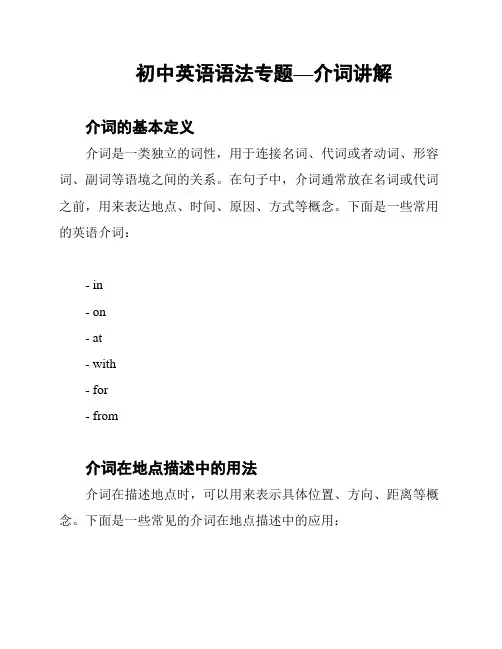
初中英语语法专题—介词讲解介词的基本定义介词是一类独立的词性,用于连接名词、代词或者动词、形容词、副词等语境之间的关系。
在句子中,介词通常放在名词或代词之前,用来表达地点、时间、原因、方式等概念。
下面是一些常用的英语介词:- in- on- at- with- for- from介词在地点描述中的用法介词在描述地点时,可以用来表示具体位置、方向、距离等概念。
下面是一些常见的介词在地点描述中的应用:- in:用于表示在某个范围之内的位置,例如 "in the room"(在房间里),"in the park"(在公园里)。
- on:用于表示在表面、平台或者位置上的状态,例如 "on the table"(在桌子上),"on the bus"(在公交车上)。
- at:用于表示在某个具体位置或者地点,例如 "at the cinema"(在电影院),"at school"(在学校)。
- to:用于表示朝向某个位置的移动,例如 "go to the park"(去公园)。
介词在时间描述中的用法介词在描述时间时,可以用来表示具体时间、时间段等概念。
下面是一些常见的介词在时间描述中的应用:- at:用于表示具体的时间点,例如 "at 7 o'clock"(在7点钟)。
- on:用于表示具体的日期或者星期几,例如 "on Monday"(星期一),"on January 1st"(1月1日)。
- in:用于表示较长的时间段或者某一个时间段内,例如 "inthe morning"(早上),"in July"(在七月)。
介词在原因描述中的用法介词在描述原因时,可以用来表示某事的起因或者原因。
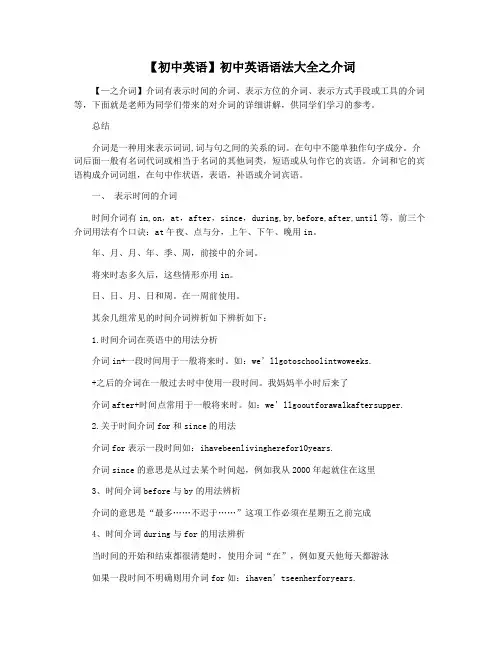
【初中英语】初中英语语法大全之介词【—之介词】介词有表示时间的介词、表示方位的介词、表示方式手段或工具的介词等,下面就是老师为同学们带来的对介词的详细讲解,供同学们学习的参考。
总结介词是一种用来表示词词,词与句之间的关系的词。
在句中不能单独作句字成分。
介词后面一般有名词代词或相当于名词的其他词类,短语或从句作它的宾语。
介词和它的宾语构成介词词组,在句中作状语,表语,补语或介词宾语。
一、表示时间的介词时间介词有in,on,at,after,since,during,by,before,after,until等,前三个介词用法有个口诀:at午夜、点与分,上午、下午、晚用in。
年、月、月、年、季、周,前接中的介词。
将来时态多久后,这些情形亦用in。
日、日、月、日和周。
在一周前使用。
其余几组常见的时间介词辨析如下辨析如下:1.时间介词在英语中的用法分析介词in+一段时间用于一般将来时。
如:we’llgotoschoolintwoweeks.+之后的介词在一般过去时中使用一段时间。
我妈妈半小时后来了介词after+时间点常用于一般将来时。
如:we’llgooutforawalkaftersupper.2.关于时间介词for和since的用法介词for表示一段时间如:ihavebeenlivingherefor10years.介词since的意思是从过去某个时间起,例如我从2000年起就住在这里3、时间介词before与by的用法辨析介词的意思是“最多……不迟于……”这项工作必须在星期五之前完成4、时间介词during与for的用法辨析当时间的开始和结束都很清楚时,使用介词“在”,例如夏天他每天都游泳如果一段时间不明确则用介词for如:ihaven’tseenherforyears.5.时态介词till和till用法的异同till和until用在肯定句中,均可表示“直到…为止”,如:iwillwaittill(until)seveno'clock.Till和Till用于否定句。
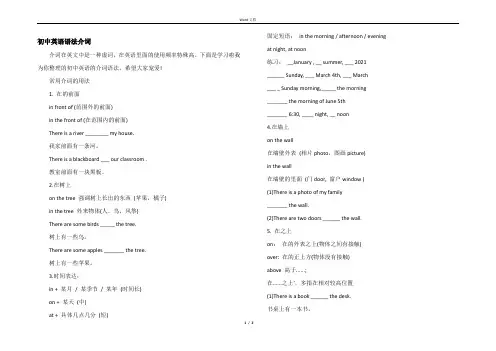
初中英语语法介词介词在英文中是一种虚词,在英语里面的使用频率特殊高。
下面是学习啦我为你整理的初中英语的介词语法,希望大家宠爱!常用介词的用法1. 在的前面in front of (范围外的前面)in the front of (在范围内的前面)There is a river ________ my house.我家前面有一条河。
There is a blackboard ___ our classroom .教室前面有一块黑板。
2.在树上on the tree 强调树上长出的东西(苹果,橘子)in the tree 外来物体(人,鸟,风筝)There are some birds _____ the tree.树上有一些鸟。
There are some apples _______ the tree.树上有一些苹果。
3.时间表达:in + 某月/ 某季节/ 某年(时间长)on + 某天(中)at + 具体几点几分(短) 固定短语:in the morning / afternoon / evening at night, at noon练习:__January , __ summer, ___ 2021______ Sunday, ___ March 4th, ___ March___ _ Sunday morning,_____ the morning_______ the morning of June 5th_______ 6:30, ____ night, __ noon4.在墙上on the wall在墙壁外表(相片photo,图画picture)in the wall在墙壁的里面(门door, 窗户window )(1)There is a photo of my family_______ the wall.(2)There are two doors ______ the wall.5. 在之上on:在的外表之上(物体之间有接触)over: 在的正上方(物体没有接触)above 高于......;在......之上',多指在相对较高位置(1)There is a book ______ the desk.书桌上有一本书。
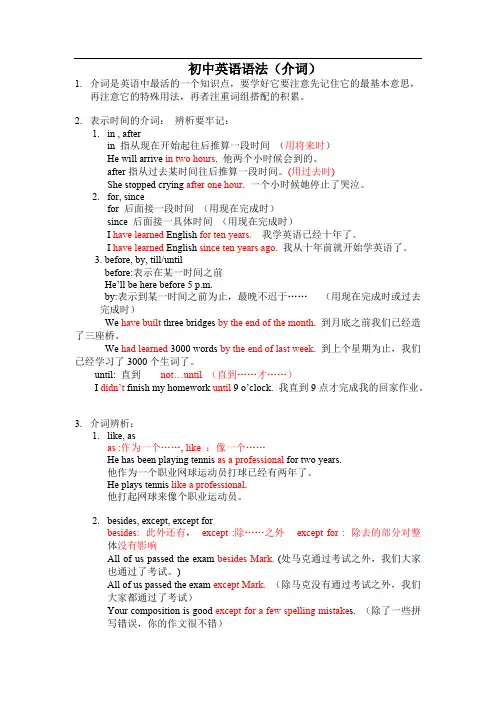
初中英语语法(介词)1.介词是英语中最活的一个知识点,要学好它要注意先记住它的最基本意思,再注意它的特殊用法,再者注重词组搭配的积累。
2.表示时间的介词:辨析要牢记:1.in , afterin 指从现在开始起往后推算一段时间(用将来时)He will arrive in two hours. 他两个小时候会到的。
after指从过去某时间往后推算一段时间。
(用过去时)She stopped crying after one hour. 一个小时候她停止了哭泣。
2.for, sincefor 后面接一段时间(用现在完成时)since 后面接一具体时间(用现在完成时)I have learned English for ten years. 我学英语已经十年了。
I have learned English since ten years ago. 我从十年前就开始学英语了。
3. before, by, till/untilbefore:表示在某一时间之前He’ll be here before 5 p.m.by:表示到某一时间之前为止,最晚不迟于……(用现在完成时或过去完成时)We have built three bridges by the end of the month. 到月底之前我们已经造了三座桥。
We had learned 3000 words by the end of last week.到上个星期为止,我们已经学习了3000个生词了。
until: 直到not…until(直到……才……)I didn’t finish my homework until 9 o’clock. 我直到9点才完成我的回家作业。
3.介词辨析:1.like, asas :作为一个……, like :像一个……He has been playing tennis as a professional for two years.他作为一个职业网球运动员打球已经有两年了。
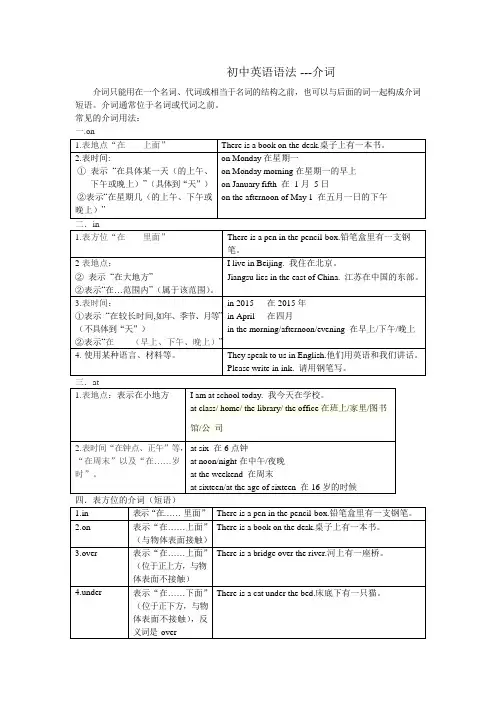
初中英语语法 --- 介词介词只能用在一个名词、代词或相当于名词的结构之前,也可以与后面的词一起构成介词短语。
介词通常位于名词或代词之前。
常见的介词用法:一.on五.其他常用介词练一练用适当的介词填空morning .2.Do the students stay home S a t u r d a y? 3.M y m o t h e r c u t t h e c a k ea knife4.We live a n e w h o u s e n o w.5.S h a n g h a i i sthe east of China.6.I usually have lunch noon.7.It’s eight o’clock.It’s time class.8.half past six , he usually has dinner.9.We have lessons eight o’clock twelve o’clock.11.There is a bridge the river.12.This is a photo my family.13.Tom comes England.14.My bed is the window.15.He looks his father.16.What's this English?17.The pen is the pencil-box.18.The bookstore is19.There are some pictures the right of our school.the wall.20.My telephone is the bed and the sofa.答案:1. at; in 2.at; on 3.with 4. in 5.in 6.at 7.for 8.At 9.from; to 10. with; by 11. over 12. of 13. from 14. near 15. like 16. in 17. in 18. on 19.on 20.between“”“”At the end, Xiao Bian gives you a passage. Minand once said, "people who learn to learn are very happy people.". In every wonderful life, learning is an eternal theme. As a professional clerical and teaching position, I understand the importance of continuous learning, "life is diligent, nothing can be gained", only continuous learning can achieve better self. Only by constantly learning and mastering the latest relevant knowledge, can employees from all walks of life keep up with the pace of enterprise development and innovate to meet the needs of the market. This document is also edited by my studio professionals, there may be errors in the document, if there are errors, please correct, thank you!。
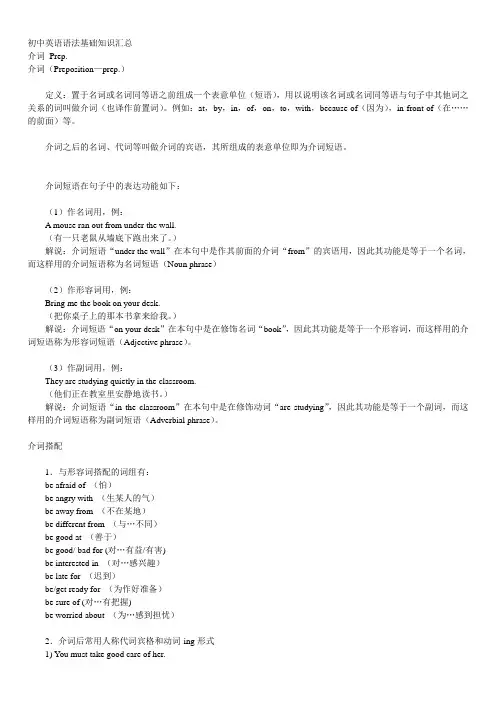
初中英语语法基础知识汇总介词Prep.介词(Preposition—prep.)定义:置于名词或名词同等语之前组成一个表意单位(短语),用以说明该名词或名词同等语与句子中其他词之关系的词叫做介词(也译作前置词)。
例如:at,by,in,of,on,to,with,because of(因为),in front of(在……的前面)等。
介词之后的名词、代词等叫做介词的宾语,其所组成的表意单位即为介词短语。
介词短语在句子中的表达功能如下:(1)作名词用,例:A mouse ran out from under the wall.(有一只老鼠从墙底下跑出来了。
)解说:介词短语“under the wall”在本句中是作其前面的介词“from”的宾语用,因此其功能是等于一个名词,而这样用的介词短语称为名词短语(Noun phrase)(2)作形容词用,例:Bring me the book on your desk.(把你桌子上的那本书拿来给我。
)解说:介词短语“on your desk”在本句中是在修饰名词“book”,因此其功能是等于一个形容词,而这样用的介词短语称为形容词短语(Adjective phrase)。
(3)作副词用,例:They are studying quietly in the classroom.(他们正在教室里安静地读书。
)解说:介词短语“in the classroom”在本句中是在修饰动词“are studying”,因此其功能是等于一个副词,而这样用的介词短语称为副词短语(Adverbial phrase)。
介词搭配1.与形容词搭配的词组有:be afraid of (怕)be angry with (生某人的气)be away from (不在某地)be different from (与…不同)be good at (善于)be good/ bad for (对…有益/有害)be interested in (对…感兴趣)be late for (迟到)be/get ready for (为作好准备)be sure of (对…有把握)be worried about (为…感到担忧)2.介词后常用人称代词宾格和动词-ing形式1) You must take good care of her.2) Thank you for teaching us so well.3.几组易混淆的介词A.“在...之后”in + 一段时间(用于一般将来时)after + 一段时间(用于一般过去时)after + 一点时间(常用于一般将来时)如:The baby stopped crying after half an hour.The baby will stop crying in half an hour.They will visit their teacher after Friday.B.for +一段时间since +过去的一点时间这两者均用于现在完成时,具体在时态部分,我会继续向同学们讲解。
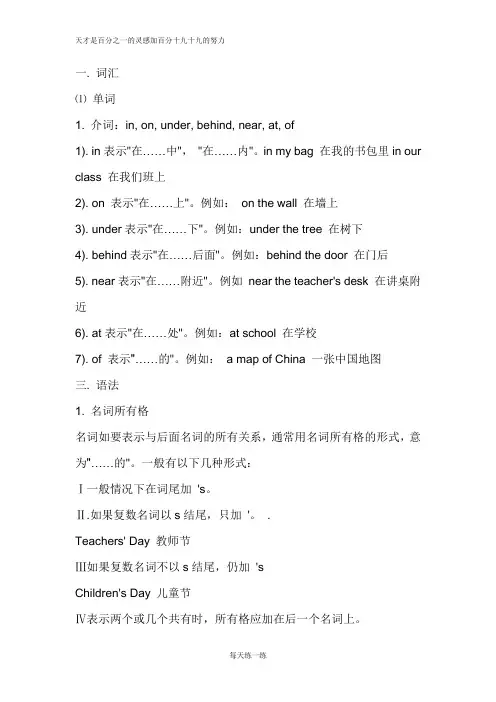
一. 词汇⑴单词1. 介词:in, on, under, behind, near, at, of1). in表示"在……中","在……内"。
in my bag 在我的书包里in our class 在我们班上2). on 表示"在……上"。
例如:on the wall 在墙上3). under表示"在……下"。
例如:under the tree 在树下4). behind表示"在……后面"。
例如:behind the door 在门后5). near表示"在……附近"。
例如near the teacher's desk 在讲桌附近6). at表示"在……处"。
例如:at school 在学校7). of 表示"……的"。
例如:a map of China 一张中国地图三. 语法1. 名词所有格名词如要表示与后面名词的所有关系,通常用名词所有格的形式,意为"……的"。
一般有以下几种形式:Ⅰ一般情况下在词尾加's。
Ⅱ.如果复数名词以s结尾,只加'。
.Teachers' Day 教师节Ⅲ如果复数名词不以s结尾,仍加'sChildren's Day 儿童节Ⅳ表示两个或几个共有时,所有格应加在后一个名词上。
ⅥLucy and Lily's room Lucy 和Lily的房间.动物和无生命事物的名词的所有格一般不在词尾加"'s",而常常用介词of的短语来表示。
2. 祈使句祈使句主要用来表示说话人的请求、命令、建议、叮嘱等意图。
祈使句一般不用主语,读时用降调。
为使语气委婉、礼貌,常在句首或句尾加please 。
在句尾时,please前多用逗号。
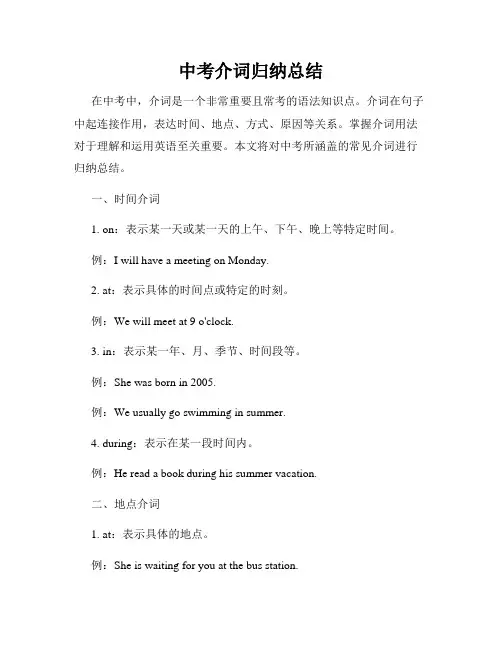
中考介词归纳总结在中考中,介词是一个非常重要且常考的语法知识点。
介词在句子中起连接作用,表达时间、地点、方式、原因等关系。
掌握介词用法对于理解和运用英语至关重要。
本文将对中考所涵盖的常见介词进行归纳总结。
一、时间介词1. on:表示某一天或某一天的上午、下午、晚上等特定时间。
例:I will have a meeting on Monday.2. at:表示具体的时间点或特定的时刻。
例:We will meet at 9 o'clock.3. in:表示某一年、月、季节、时间段等。
例:She was born in 2005.例:We usually go swimming in summer.4. during:表示在某一段时间内。
例:He read a book during his summer vacation.二、地点介词1. at:表示具体的地点。
例:She is waiting for you at the bus station.2. on:表示表面或某物之上。
例:There is a book on the table.3. in:表示在某个范围、区域、国家或大洲内。
例:We live in a small town.4. to:表示朝向、方向。
例:He went to the library.三、方式介词1. by:表示通过某种交通方式或手段。
例:I usually go to school by bus.2. with:表示伴随、陪同。
例:She walks to school with her friends.3. in:表示用某种方式或手段。
例:He communicated with her in English.四、原因介词1. for:表示目的、原因或理由。
例:He went to the store for some milk.2. because of:表示因为。
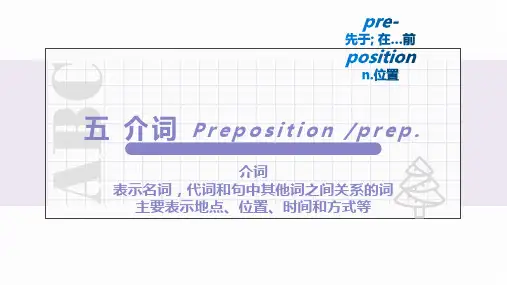
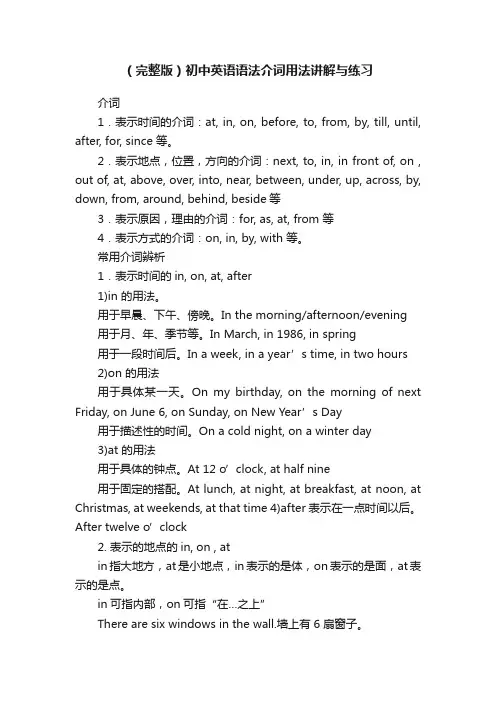
(完整版)初中英语语法介词用法讲解与练习介词1.表示时间的介词:at, in, on, before, to, from, by, till, until, after, for, since 等。
2.表示地点,位置,方向的介词:next, to, in, in front of, on , out of, at, above, over, into, near, between, under, up, across, by, down, from, around, behind, beside等3.表示原因,理由的介词:for, as, at, from 等4.表示方式的介词:on, in, by, with 等。
常用介词辨析1.表示时间的in, on, at, after1)in 的用法。
用于早晨、下午、傍晚。
In the morning/afternoon/evening用于月、年、季节等。
In March, in 1986, in spring用于一段时间后。
In a week, in a year’s time, in two hours2)on 的用法用于具体某一天。
On my birthday, on the morning of next Friday, on June 6, on Sunday, on New Year’s Day用于描述性的时间。
On a cold night, on a winter day3)at 的用法用于具体的钟点。
At 12 o’clock, at half nine用于固定的搭配。
At lunch, at night, at breakfast, at noon, at Christmas, at weekends, at that time 4)after 表示在一点时间以后。
After twelve o’clock2. 表示的地点的in, on , atin指大地方,at是小地点,in表示的是体,on表示的是面,at表示的是点。
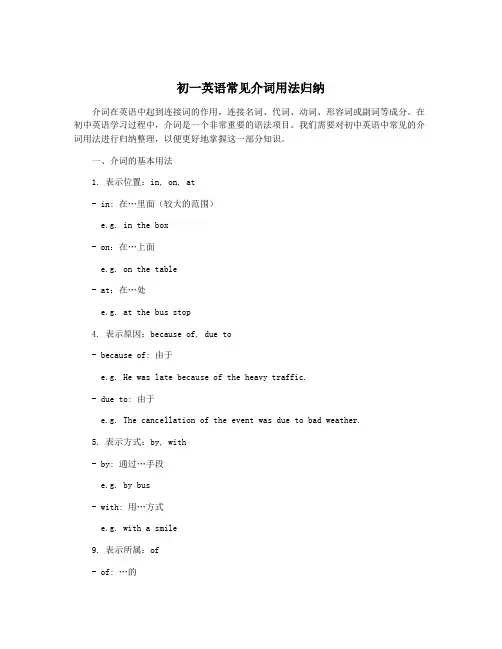
初一英语常见介词用法归纳介词在英语中起到连接词的作用,连接名词、代词、动词、形容词或副词等成分。
在初中英语学习过程中,介词是一个非常重要的语法项目。
我们需要对初中英语中常见的介词用法进行归纳整理,以便更好地掌握这一部分知识。
一、介词的基本用法1. 表示位置:in, on, at- in: 在…里面(较大的范围)e.g. in the box- on:在…上面e.g. on the table- at:在…处e.g. at the bus stop4. 表示原因:because of, due to- because of: 由于e.g. He was late because of the heavy traffic.- due to: 由于e.g. The cancellation of the event was due to bad weather.5. 表示方式:by, with- by: 通过…手段e.g. by bus- with: 用…方式e.g. with a smile9. 表示所属:of- of: …的e.g. the hat of the boy2. look forward to: 期待e.g. I am looking forward to the summer vacation.5. be interested in: 对…感兴趣e.g. Amy is interested in learning Chinese.三、常见介词错误用法及纠正1. 错误用法:depend of正确用法:depend one.g. We depend on each other.通过以上的介词错误用法及纠正,我们可以更清晰地了解该如何正确使用这些介词。
四、综合练习通过上述的综合练习,可以帮助大家更好地掌握介词用法。
初中英语语法:介词的用法归纳介词是一种用来表示词与词,句子与句子之间关系的词。
介词是一种虚词,不能独立使用。
介词之后一般有名词或代词(宾格)或相当于名词的其他词类、短语或从句作它的宾语,即构成介词短语。
有些介词是由两个以上的词构成的短语介词,如:out of(从…中出来),because of(因为),away from(距离…),on top of(在…顶上),ever since(自从…),next to(在…隔壁),according to(根据…),in front of(在…前方)等。
一、介词的分类1、按构成方式,可分为:①简单介词:即一个介词;②合成介词:由两个介词构成合成词;③短语介词:由短语构成;④双重介词:由两个介词搭配而成;⑤分词介词:由现在分词转化而来;⑥兼类介词:由形容词直接转化而来;2、按所表示的意义,可分如下几类:①地点(位置、范围)介词;②方向(目标趋向)介词;③时间介词;④方式介词;⑤涉及介词;⑥其它介词:目的介词,原因介词,比较介词,伴随/状态介词。
二、介词短语的句法作用介词与其宾语一起构成的短语叫做介词短语,可在句子中充当一定成分,通常用作状语、定语和表语和宾语补足语。
如:The man camedown the stairs。
(状)(那个人走下楼来)The womanwith a flower on her headisfrom the countryside.(定)(头上戴花的妇女来自乡下)The teacher is nowwith the pupils.(表)(老师现在和学生在一起)When she woke up,she found herselfin hospital.(宾补)当她醒来时,发现自己已经在医院里。
三、介词短语在句子中的位置介词短语做状语时,如果表示时间/地点,可以放在句首或句尾。
如果表示方向/方式/伴随/涉及/原因/目的/比较,一般放在句尾;介词短语作表语时放在连系动词之后;介词短语作定语时,只能放在被修饰的名词之后。
在初中英语学习过程中,介词是非常活跃的词汇,它们用于表达事物之间的关系,特别是在句子中作为连接词。
以下是对初中英语学生可能遇到的一些基本介词的汇总:1. about:表示涉及或关于某个主题。
- She knows something about music.2. after:表示在时间、顺序或位置上的后。
- I will see you after school.3. along:表示沿着某个方向。
- We walked along the river.4. as:表示作为或当作。
- She works as a teacher.5. among:表示在多个事物之间。
- There are many books among the papers.6. at:表示位置、时间或动作的目标。
- He is sitting at the desk.7. before:表示在时间或顺序之前。
- I ate breakfast before I went to school.8. behind:表示在某个物体的后面。
- The cat is behind the chair.9. below:表示在某个物体的下面。
- The river is below the bridge.10. beside:表示在某物体旁边。
- She stood beside the tree.11. between:表示在两个物体之间。
- The book is between the two glasses.12. by:表示通过、被、在旁边等意思。
- He passed by the door.13. down:表示向下或沿着某个方向。
- We went down the stairs.14. during:表示在某段时间内。
- I read a book during the vacation.15. except:表示除了某个物体或情况之外。
初中英语语法基础介词专题讲解一.介词at/ in /on .1.表示时间:1).表示某一具体时间点,某一时刻/ 年龄at six o’clock at noon at that timeat the moment at the age of at night2)in表示时间段,一天的三个时间段以及月份,年,季节,世纪,人生的某个时期(某人几十岁时)in the morning/afternoon /eveningin spring /in 2007/in Marchin the twenty-first centuryin his fifties3)on表示星期几/某一具体的日子/具体某天的上午/下午/晚上,表示一天中的三个时间段名词前有修饰语或后有修饰语时.On Monday on New Year’s Dayon Sunday morning on a rainy nighton the evening of April 1st ,20072表地点:1)at 一般指较小的地点或较具体的位置at the station at the cinema2)in 表示在较大的地点或一个有限空间里.in China in the classroom3)on 指在某物体的表面上.on the desk注意:写街道时,若有门牌号用at ,否则用on / in 都可.He lives at 270 DongChang’an Street.二.介词in /on / to 表方位:1.in表示A地在B地范围之内.(包含关系)Tanwan is ____ the southeast of China .2.on表示A,B地接壤.(外切关系)Hubei is ____ the north of Hunan .3.to表示A,B两地有一定的间距.(外离关系)Japan is _____ the east of China .三. between / among 在……之间1.between :指两者之间. 在…….之间.2.among :用于三者或三者以上人或物之间. 在……之中.You sit _____ him and me .The song is popular ______ the students.四.after / in 在……之后 before / in 在……之前1. after1)after + 时间段. 表示以过去某一时刻为起点的一段时间之后, 用于过去时.2)after 作介词. after doing sth.2.in +一段时间. 表示说话时或以现在为起点的将来一段时间之后.用于将来时.He came back ______ two days .He will go home___finishing his homework .He will come back _____ two days .3. before 多用于时间点或一件事之前发生,即“先于……;在……之前”He left the office bofore I got there. I’ll be back before five o’clock.4. ago 时间段+ ago 表示“多久之前”时态通常用:一般过去时I met Tom two days ago.五.with / in / by 表示“用……”1.with 表示“用…” 一般指有形的工具/ 手段/ 人体器官.He cut the apple into halves ____ a knife .注: with 表伴随, “带有,含有”He came in _____ a big smile on his face .2.in表示用某种语言,方式,途径. 或书写/绘画所用的材料. 也可表交通方式.Can you say it _____English ?He wrote a letter ____ blue ink .3.by表示乘坐交通工具, 表示方式,方法I study for a test _____ working with a group .He makes a living ____ selling newspapers .注意: 同义词组1).by phone = on the phone2).by car = in a car3).in pen = with a pen = with pens六.across / through / over / by 经过1.across 指横穿,穿过. 表示动作从某一物体表面上经过.2.through 指穿过,透过,表示从某一物体空间内通过.3.over 表示从某人或某物的上空经过或越过,不与表面接触.4.by 表示从某人/某物的旁边经过.Can you swim ______ the river ?the elephant is so big that it can’t go _____ the gate .I don’t think anyone can jump ___ the fenc e.I walked _____ the bank of China yesterday .七.in front of / in the front of1.in the front of 表示在…….内部的前面2.in front of 表示在……外面的前面There is a desk in _____ front of our classroom .There is a big tree in _____ front of our classroom.八.其它介词的用法:1.at的其它用法.1).表示“从事或正在做某事”,其后加的名词往往不加冠词.She is at work now = She is working now .2)at表示“价格或速度”The train ran at 120 kilometers an hour .2.in的其它用法:1)in表示“在……方面”词组:do well in = be good atbe weak in2)in 表示“穿着”后接表颜色的词或衣服.词组: be in +衣服= be wearing +衣服3)in作副词, “在家” = at home3.like 的用法:1).像/和……一样. 常与系动词连用.词组: look like sound like2).与what 连用, “是什么样子, 怎样”.What is he like ? He is kind .4.off的用法:1).从……下来, 脱离某物体.词组: fall off2). “休假”通常放在时间名词之后.词组: have +时间+ offHe has n’t had a night off for two hours .5.except / besides1).except 除了…….之外, 都……. . 不包括在范围之内.注: nothing but … 除了……之外,什么也没有.2).besides除了……之外,还有…… . 包括在范围之内.We all went swimming ______ Lucy .There is _______ a letter in the box .We study Japanese and French____ English .6.with / without1).with具有,含有反义词: without 没有词组: with the help of = with one’s help =because of = thanks towithout one’s help2).without 的用法:A).without + sb./ sth. 没有某人或某物B).without + doing sth . He lef t here without____(say ) “Goodbye”to usC). without sth 常与if 引导的否定的条件句.If there is no water , we can’t live .= We can’t live ______ _______ .7.on the tree /in the treeon the tree 表示“树上本身长的东西” 在树上.in the tree 表示“外界的物体进入树中” 人或物在树上.There are some apples _____ the tree .There is a boy ____ the tree.8.表示“数量的介词”about , round around , over1). about , round around表示“大约……”2).over 表示“超过”= more than.9.inside / outsideInside 在……里面------反义词:outside在….外面10.in the wall /on the wallin the wall 表示“门窗在墙上” on the wall 表示“某东西张贴或挂在墙上”九.不用介词的情况:1).当时间状语为: tonight, today, yesterday, tomorrow 等时,不用介词. What are you going to do tonight ?2).含有this, that, these, those, last, next, every/each day等时间状语.He went to Wuhan last week . I drink milk every day.3).以all 开头的时间状语前面不用介词.He has worked all day .4).以some ,any, one 等构成的时间状语前不用介词.He met a bad man one cold morning. = He met a bad man on a cold morning.介词专题小测:一、单项选择题。
初中介词的用法初中英语中介词的用法主要有以下几种:1. 表示时间:in、on、at。
in表示某个时间段,如“in the morning”(早上),“in the afternoon”(下午)。
on表示某个具体时间,如“on Sunday”(在星期天),“on June 12th”(在6月12日)。
at表示某个具体的时间点,如“at 3 o'clock”(在3点钟)。
2. 表示地点:in、on、at。
in表示在某个空间内部,如“in the room”(在房间里)。
on表示在某个物体的表面,如“on the table”(在桌子上)。
at表示在某个位置或目标,如“at the school”(在学校)。
3. 表示方式:by、with、in。
by表示通过某种方式或手段,如“by bus”(乘公交车)。
with表示使用某种工具或伴随某种状态,如“with a pen”(用笔)。
in表示以某种语言或方式,如“in English”(用英语)。
4. 表示比较:than、as、like。
than用于比较级,表示比较关系,如“she is taller than him”(她比他高)。
as用于同级比较,表示“和……一样”,如“she is as tall as him”(她和一样高)。
like用于比喻或类比,表示相似性,如“she is like a tall tree”(她像一棵高大的树)。
5. 表示原因:because、since、for。
because表示直接原因,强调主观动机或解释,如“I am late because I overslept”(我迟到了因为我睡过头了)。
since表示已知事实作为推理依据,强调客观原因,如“Si nce you are not available, I will do it myself”(既然你不能来,我自己来)。
for表示原因或目的,强调行为的目的或结果,如“I bought a book for my sister's birthday gift”(我买了一本书作为我妹妹的生日礼物)。
初中英语知识点归纳常用的介词和介词短语介词是一种连接词,位于句子中,可以表达位置、方向、时间、原因、目的等含义。
在英语学习中,熟练掌握常用的介词和介词短语是非常重要的。
本文将对初中英语中常用的介词和介词短语进行归纳总结,帮助读者更好地理解和运用。
一、位置和方向类介词1. in :表示在某个具体空间或范围内e.g. in the room(在房间里)2. on :表示在某个平面或垂直面上e.g. on the table(在桌子上)3. at :表示在某个位置或地点e.g. at the park(在公园)4. under :表示在某物体的下方e.g. under the chair(在椅子下面)5. above :表示在某物体的上方e.g. above the clouds(在云层上)6. behind :表示在某物体的后方e.g. behind the door(在门后面)7. in front of :表示在某物体的前方e.g. in front of the building(在建筑物前面)二、时间类介词1. at :表示具体的时间点e.g. at 8 o'clock(在8点钟)2. on :表示在某一天或日期e.g. on Monday(在星期一)3. in :表示在某一段时间或月份e.g. in the morning(在早上)4. after :表示在某个时间之后e.g. after school(放学后)5. before :表示在某个时间之前e.g. before dinner(晚饭前)三、原因和目的类介词1. because of :表示由于某个原因e.g. He couldn't come because of the bad weather.(因为天气不好,他不能来。
)2. thanks to :表示由于某个好事发生e.g. Thanks to his help, I passed the exam.(多亏了他的帮助,我通过了考试。